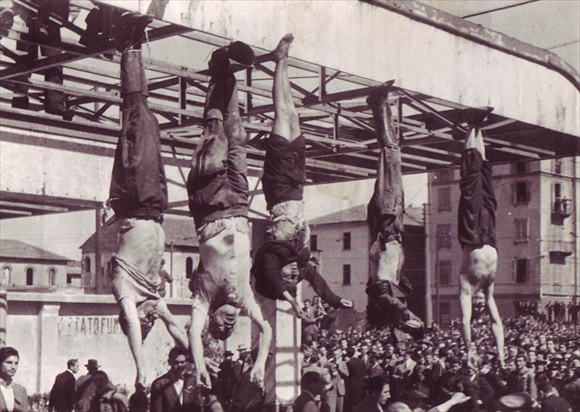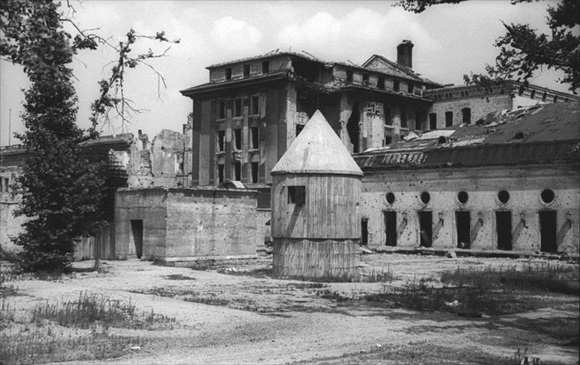ITALIAN PARTISANS CAPTURE MUSSOLINI
Dongo near Lake Como, Northern Italy · April 27, 1945
On this date in 1945, with the Wehrmacht (German armed forces) in Italy in full retreat—indeed, their commanders had signed surrender documents on this date—Italian strongman Benito Mussolini was en route to a safe haven in Switzerland. The Duce (Italian for “leader”) was wearing a German noncommissioned officers overcoat and helmet in a truck convoy of German troops. When the Germans were searched by a group of Italian partisans near Dongo on Lake Como, Mussolini’s unmistakable features gave him away amid loud cries of “We have got Mussolini!”
The next day Mussolini and his 33-year-old mistress, Claretta Petacci, were pushed into a car. When the car later stopped, the two prisoners were ordered out and pumped full of bullets fired from a submachine gun. Their executioner, a member of the North Italian Committee of National Liberation, reportedly exclaimed at the time, “I execute the will of the Italian people.” The bodies of Mussolini and Petacci, plus those of fourteen other members of Italy’s Fascist leadership, were brought to the Northern Italian city of Milan for public display, then mutilated and strung upside down on butchers’ hooks in the Piazzale Loreto, the huge open square where fifteen Italian anti-Fascists had been executed by Mussolini’s Blackshirts the year before.
Mussolini’s comrade-in-arms Adolf Hitler, hiding in the clammy recesses of his Fuehrerbunker under the wrecked Reich Chancellery in Berlin, heard Radio Stockholm’s announcement of the Duce’s death. Whether he also learned the gory details of Mussolini’s end is uncertain. But it would only have reaffirmed his desire to take his own life before it was too late, and to prevent his body from being seized and put on display by his enemies.
To that end, with the Red Army within a stone’s throw of his bunker and the Chancellery garden, Hitler ordered his personal adjutant to obtain as much gasoline as possible. Within minutes of the suicides of Hitler and his wife Eva Braun, their bodies were laid side by side in the sandy soil only yards from the door leading into the garden. Shortly before 3:00 p.m., five barrels of gasoline were poured over the remains and set on fire. As the men of the funeral party watched the corpses burn, they gave their dead Fuehrer one last Hitler salute and scurried back into the protection of the bunker when Soviet artillery shells started falling into the garden.
[amazon_carousel widget_type=”ASINList” width=”600″ height=”200″ title=”Recommended Reading” market_place=”US” shuffle_products=”False” show_border=”False” asin=”030759582X,081296859X,0143122134,0312373961,0393322521,0684803291,1589790952,1842126067,0312614926,0306806886″ /]
Inglorious End of the Dictators
 |
Above: Displayed in the Piazzale Loreto, Milan’s major town square, on April 29, 1945, is the grime-covered corpse of Benito Mussolini (second from left) and, to his right, that of his mistress, Claretta Petacci, along with the remains of other executed Fascists, primarily ministers and officials of Mussolini’s Nazi puppet state Repubblica Sociale Italiana (Italian Social Republic, or simply Salò Republic). Mussolini was shot through his forehead near the village of Dongo on Lake Como close to the Swiss border late the previous afternoon. His body was taken in a closed van to Milan, the city where Italian Fascism was born in 1919, and dumped in the same spot where the year before Fascist squads had exhibited the bodies of fifteen Milanese civilians (the so-called “Martyrs of Piazzale Loreto”) whom they had killed in retaliation for partisan activity. A howling mob of more than 5,000 people kicked and spat on Mussolini’s remains before his body was hung upside down at a gas station.
 |
Above: Per instructions, Adolf Hitler’s body and that of his wife and former long-time mistress Eva Braun were carried up the stairs through the bunker’s emergency exit, as seen in this photo facing a tree, doused in gasoline, and set alight in the desolated Reich Chancellery garden. Soviet archives record that their burnt remains were recovered and interred in successive locations in Eastern Germany until 1970, when they were again exhumed, cremated, and their ashes scattered.
American Newsreel Reporting Benito Mussolini’s Execution
![]()

 History buffs, there is good news! The Daily Chronicles of World War II is now available as an ebook for $4.99 on Amazon.com. Containing a year’s worth of dated entries from this website, the ebook brings the story of this tumultuous era to life in a compelling, authoritative, and succinct manner. Featuring inventive navigation aids, the ebook enables readers to instantly move forward or backward by month and date to different dated entries. Simple and elegant! Click
History buffs, there is good news! The Daily Chronicles of World War II is now available as an ebook for $4.99 on Amazon.com. Containing a year’s worth of dated entries from this website, the ebook brings the story of this tumultuous era to life in a compelling, authoritative, and succinct manner. Featuring inventive navigation aids, the ebook enables readers to instantly move forward or backward by month and date to different dated entries. Simple and elegant! Click 











